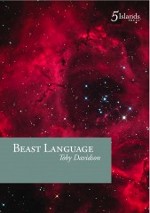
Beast Language by Toby Davidson
Five Islands Press, 2013
In the introduction to the collected poems of Francis Webb, Toby Davidson observes that the immediate influences behind Webb’s poems ‘do not supersede his locales.’ Webb’s poems are informed by a topophilia, a love of place and its ambient lore, a topographical attentiveness to detail that includes not just spatial but also temporal resonances. Davidson has inherited this attentiveness to space and place, and his debut collection, Beast Language, attempts a topo or ecopoetics that traverses a spectrum of geographies, mapping the Australian continent from the Indian Ocean to the Pacific seaboard, attempting not only terrestrial readings but taking cosmological measurements as well.
The collection is ambitious in range and reach, with its triptych structure mirroring the human seasons of growth, birth and maturity, threaded through with allusions to myths both Indigenous and Greek. However, it is not in the grander cosmic vision but in close observations of natural details that Davidson’s imaginative sensibility is at its most engaging. In the title poem, the visual representation is almost Palaeolithic, the invocation of Picasso lending the exhibit a Guernica-like resonance:
Eight steers, some with snouts by Picasso
marked in chalk on shimmering hides,
break from stillness to outflank the curio
woofing and scuffing at not quite a trot.
The formal stanzas, albeit unrhymed, recall Webb’s formal mastery, but Davidson’s poem resists any romantic rumination or anthropomorphising, insisting on the harsh intractable reality of the landscape: ‘How they converge is cow knowledge only …’ Davidson is content to glean the unsayable off what is found, instead of imposing a meaning on the experience. Informing the landscapes and journeys in the collection is a primitive quest that upturns the pastoral and exposes the artifice of the urban. In ‘Totem and Ritual by Road’ the drive to Canberra sees ‘this nation’s capital’ as ‘an airbrushed lie’ that conceals the underlying reality:
Kangaroos too have given themselves,
sacrificed for the death of signs;
out here there are whole ontologies
hot to rot an open mind.
Nature in the Davidson’s topographical poems is not a medium or vehicle for human transcendence or transformation; neither does it foreground the human agency and experience. Instead the observed natural details signal a deeper reality, almost metaphysical, the Buddhist inclination evident in perhaps the best poem in the collection, ‘Arrival of the Sunling’:
Little bird, where have you come from?
Too buoyant for this mottled garden, you
must have escaped from a nearby commercial,
picture perfect, digitally enhanced.
But there was no hook, no spurious
truncation, you just glowed ardent yellow
like a little Buddhist whisper all might turn
on the tiniest thing. I brought you clouded water
unspilt in a prying dish. You didn’t move,
I didn’t fade. The water cleared. All
held. You stayed until I was sure.
It is a fleeting moment of equilibrium and perception, echoing Robert Frost’s ‘the Oven Bird,’ and credit to the poet for not chasing the moment and thereby reducing its mystery. Such lyric moments are the highlights of the collection, and are found in place poems like ‘Sunset, Cottesloe’ which, with its western orientation, takes in Gage Roads and its ‘hems of sphere’ and ‘longitudinal pluck,’ and ‘From Mount Zero,’ which evokes the ancient landscape through sparing and accurate observations:
Rock over sand over sand over rock. The tiniest gravitas audible. Down the face a Jardwadjali classroom seals palms to the scab of creation. Cloudlets bristle in the swirling hum, hovering heat with no hard lid. I notice grasses keep a strong shadow. I know I’m asked and spared nothing.
The poem implies an ecopoetics that, to use Jonathan Bate’s words, ‘is not a description of dwelling with the earth, not a disengaged thinking about it, but an experiencing of it’ (The Song of the Earth, 42). The reduced human agency allows the spirit of place to be embodied in the images that yoke together the visible and invisible, the earthly and unearthly, and the human and natural.
When it engages with the quotidian and with what is at hand, Beast Language evinces Davidson’s ability to convey a beauty stripped bare of ornament. There are tender poems too, of birth (‘Three Months Old’) and death (‘Bar-do’); but one wishes for more sustained human engagement, and for the poet to sustain narrative and descriptive accounts of the here and now or of memory, rather than cast his gaze outwards to galactic and postmodern tropes, as he does in ‘Two Brickettes on the Subject of Ultraviolence’ and poems inspired by computer games. There is a vagueness of imagery not just in these poems but elsewhere in the collection (‘Master of Stomachs, our powers have greyed/ absorbed for congruent, apparent eternity’). There are also instances of awkward syntax (Blushing girls return like stone fruit,/ breeze at the knees flicks a dress), and slack and lazy diction (‘It is beautiful’).
Perhaps Davidson’s reach is over-extended, and the collection’s ambitious structure and range are inadequately supported by the substance of individual poems. The key sequence ‘Religion: Road’ lacks an overall coherence; it should have given the collection a thematic and imagistic focus but loses its way among diffuse references. Its flaws notwithstanding, Beast Language announces a new voice and way of seeing in Australian poetry, and offers moments of vivid insight into place and self on the journey from the western seaboard to the Pacific coast of the continent.









